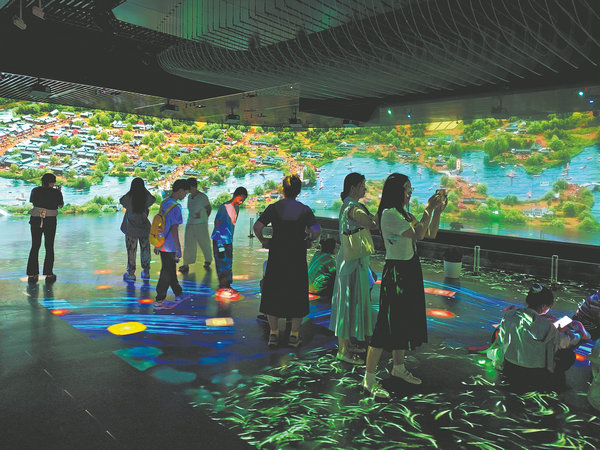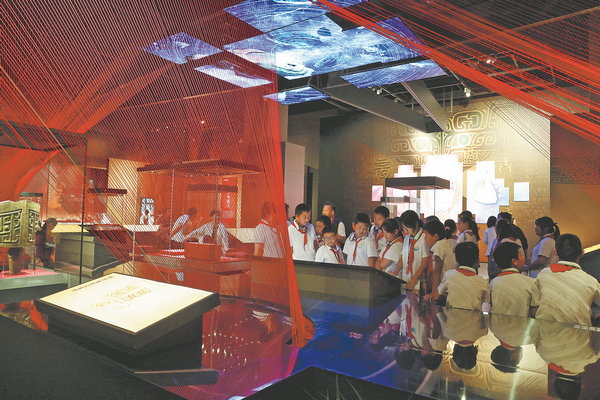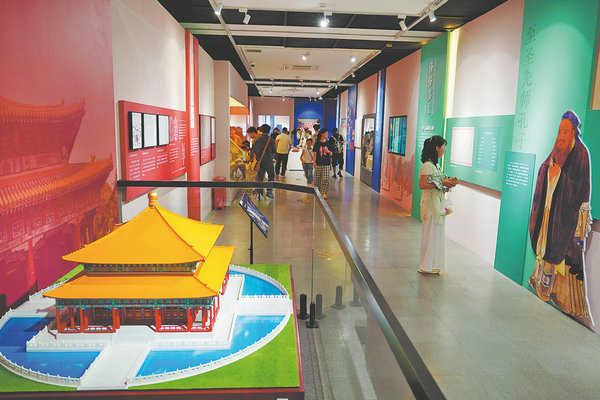
On a warm August morning at the Grand Canal Museum of Beijing, a small crowd of children huddles around a bronze treasure that has been waiting more than three millennia to be admired. The famed owl-shaped zun — a Shang Dynasty (c.16th century-11th century BC) ritual vessel symbolizing the war god — sits in its case, silent yet commanding.
Twelve-year-old Chen Mingxuan lifts an AI-enabled handheld device to eye level. The screen hums and trembles in his hands, then blooms with animation: the vessel's intricate patterns begin to glow, shifting into scenes that reveal their hidden meanings. Mingxuan lets out an excited gasp as the owl's eyes gleam to life. He then taps a button to record his own retelling of the artifact's story. Later, his narration will be embedded into a custom "talking" refrigerator magnet — a souvenir that fuses the weight of tradition with a spark of technology.
This is Return of the Mythical Beasts, one of the museum's newest education programs, developed as part of its push to reinvent how history is experienced. Situated in Tongzhou district, where the ancient Grand Canal once pulsed with trade activities, the museum has launched AI-powered terminals, crafting workshops, and immersive storytelling to draw children into the world of the Shang Dynasty.
"Our AI terminals recognize more than 100 artifacts," says Zhang Ning, head of the museum's creative culture team.
"When children record their own explanations of what they've learned, they're not just memorizing the information but also building a better understanding of history."
The program ties into the museum's This Is Shang Dynasty exhibition and its canal heritage collection. This summer, new offerings have multiplied. The Journey Through the Great Shang program uses a dual-terminal teaching system linking teachers and students in real-time. While instructors guide lessons on a master device, students receive synchronized high-resolution images, videos and text on their tablets, allowing them to zoom in on details far beyond what the glass cases reveal.
"The system tracks the students' progress and awards digital badges," Zhang notes.
"It keeps them curious, engaged and proud of what they're learning."
For those craving a dash of drama, The Shang King's Banquet Treasure Hunt begins on the eve of a royal feast, only for the bronze vessels to vanish. Armed with the king's secret orders, young sleuths follow clues through the galleries, decode bronze motifs, and try their hand at clay mold casting to crack the case.
"It's about curiosity, participation and immersion," Zhang says.
"Children leave with a tangible connection to the Shang world," she adds.
In downtown Dongcheng district, at the solemn gates of the Confucius Temple and Guozijian (Imperial College) Museum, a group of children wearing traditional hanfu costume line up before the statue of Confucius, carefully adjusting their robes and using brushes to write Chinese characters that reflect Confucius thoughts.
This signature program combines traditional rites and etiquette with immersive historical drama.

The activities guide participants through the historical layers of China's classical learning, allowing them to explore the legacy of Confucian scholarship and ritual culture in a setting that once shaped the nation's intellectual elite.
Once China's highest learning institution and a center for moral cultivation, the Imperial College draws on this profound legacy to inspire modern programs.
Personnel at the facility have developed over 300 programs serving more than 7,000 participants since 2024, receiving overwhelmingly positive feedback, says Yan Jing, director of the education department with the museum.
The two museums are among many across the capital that have rolled out learning experiences for summer vacationers.
On Aug 8, the Study Tour Month of the Beijing Museum Season was launched, aiming to create a multidimensional space to combine cultural experiences, consumption scenarios and interactive activities.
"Museums are more than repositories of history; they are cultural landmarks that preserve our legacy and pass on the heritage of civilization," said Chu Jianhao, a senior official with the Beijing Municipal Cultural Heritage Bureau, at the launch ceremony.
Chu praised the rich array of exhibitions, technology-enhanced experiences, and creative programs that have attracted a growing public audience since the inaugural edition of the Beijing Museum Season's Exhibition Month in May. Science Month was held in June, and Cultural Creativity Month took place in July.
The Study Tour Month embodies a commitment to culturalinheritance and innovative integration, he notes.
"We will collaborate with museums across Beijing's districts to deliver diverse programs, including thematic study tours, interactive games and academic seminars," Chu says.
"The goal is to transform museum resources into educational assets, enhance young people's cultural literacy, and bring high-quality cultural experiences to communities," he adds.
By building on new partnerships with educational authorities, Chu reveals five freshly designed study routes along Beijing's Central Axis, along with extended summer hours to meet rising demand.

On launch day, Dongcheng district's culture and tourism bureau unveiled a new set of themed educational travel routes that serve as a key to opening its history.
"These routes are not just a string of attractions," Chu says, adding that at each stop, organizers include various activities.
Chu calls upon participating museums to leverage Beijing's unique cultural heritage to design engaging and memorable programs for youth, ensure scholarly rigor and authenticity in historical storytelling, and embrace innovative formats including theatrical performances and digital interactivity, to enrich learning experiences.
At the Bell and Drum Towers, students can participate in role-play activities and "time wisdom" workshops, solving clues through interactive games and augmented-reality treasure hunts to discover how ancient Chinese kept time — a glimpse into how museums turn history into living, breathing adventures.
Themed routes
The Central Axis Treasure Hunt takes young participants along the city's symbolic spine, visiting the National Museum of China, the historic Peking University Red Building and the Cloisonne Art Museum of China, to uncover cultural treasures along the way.
The Drum Rhythms, New Voices route begins at the iconic Bell and Drum Towers and winds through the hutong neighborhood, the Confucius Temple and Guozijian Museum, inviting visitors to spend a day immersed in the rhythms of Beijing's historic streets.
The Wandering Through Past and Present route connects Zhengyangmen and Arrow Tower to the south of Tian'anmen Square, Qianmen Street and the Natural History Museum of China, showcasing how Beijing's traditions continue in contemporary culture.
Contact the writer at yangfeiyue@chinadaily.com.cn


